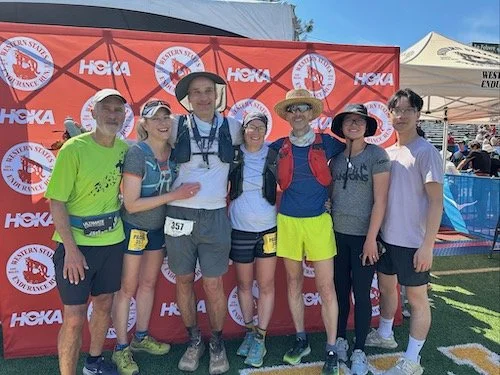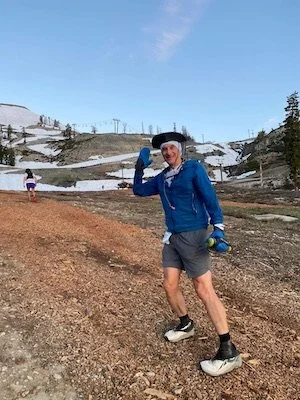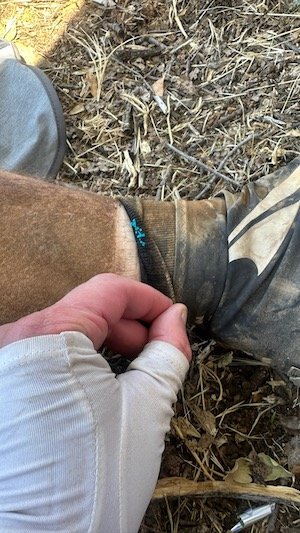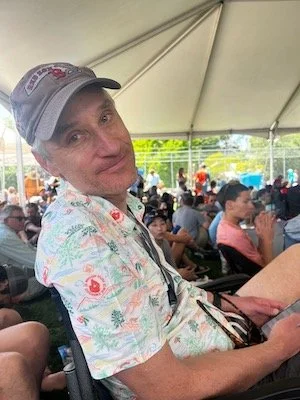I Ran 100 Miles. Here’s What I Learned About Mindset, Community, and Persistence.
Photo credit: Eddy Mo
The Western States Event
That’s me, on June 24, 2023, 55.7 miles into a 100-mile endurance run.
It wasn’t my first race at the 100-mile distance, but it was my first (and maybe only) shot at the Western States Endurance Run, the oldest 100-mile foot race in North America, and possibly the world (having started in 1974).
Its epic sweep takes runners from Olympic Valley, California (near Lake Tahoe), up and over high mountain passes and ridges, down through dizzyingly steep canyons, like a descending roller coaster, to the Middle Fork of the American River and, ultimately, the Sierra foothills town of Auburn, California, where runners finish on the track at Placer High School. By the finish, runners have climbed about 18,000 feet and descended about 23,000.
You’re catching me at rock bottom. After a day with stretches of gratitude, wonder, and practiced focus, at some point something changed, and I’ve just spent 17-plus steep, dusty miles, and about 5 ½ hours, saying mean things to myself about how slowly I’m moving, how bad I am at executing race plans at this distance, how much faster I should be moving with the cool conditions…you name it.
But I’m getting ahead of myself.
Since 2017 I’d been training hard to finish long “qualifier” trail races and earn a spot in the (in)famous annual lottery for a coveted spot in “States,” as the race is affectionately known in the ultramarathon-running (or, “ultrarunning”) community. Lottery day — the first Saturday each December — yielded disappointment after disappointment, even as my ticket count doubled each year.
Finally, last December 3, I awoke to a text message from a former coach, telling me my name had been drawn. Colette — my spouse, life partner, and fellow ultrarunner — and I were giddy, and immediately kicked into planning mode: Who should be my crew, taking care of me at various points along the route? Who should be my pacers, accompanying me over the final 40ish miles? Was there somewhere we could stay the week before the race, to help acclimatize to the 6,200-foot elevation of the start line at Olympic Valley? And many, many more questions.
Fast-forward to 5:00 a.m. on June 24, when the race officially began. Everything from training to logistics to the cooler-than-expected weather forecast had gone as well as I’d hoped for, or better. A head cold two days before the race was an unhappy surprise, but I wasn’t about to withdraw and send myself back to the lottery. I knew this was probably my only shot at finishing States: it could take years to get back into the race, and at 55, I’ve begun feeling the steepening downhill trend that inevitably comes with age.
Head cold be damned: this was it.
Even for the fastest runners, the tale of a 100-mile race is long: full of literal and figurative ups and downs, moments of despair and exhilaration, and chance after chance for epiphanies great and small. For folks who run at a pace like I ran States in 2023, the tale is longer still. So, you may be relieved to know that I’m not here to tell you the story of my whole race. I may tell that story one day, but not here, not now. Today, I’ll simply share a bit about the moment in the photo, how it fed into the rest of my race, and how it’s helped me learn and relearn some key life lessons that anyone can apply.
Beware the Chair
It’s bedrock wisdom in the ultrarunning community: unless you need to change your shoes, tend to an injury, or do something else that really, truly requires you to sit down, you should avoid sitting at all costs.
I arrive at Michigan Bluff aid station, Mile 55.7, greeted by an arch of brightly colored balloons, music pumping, and — the ultimate show of support in the trail-running community — cowbells ringing. I’m an hour ahead of the race cutoff (the absolute deadline for leaving the aid station) and desperately needing a “reset.”
Or, that’s what I’ve been telling myself. If you ask me what I mean by “reset,” I won’t be able to tell you anything coherent. I probably mean something like, “I want to feel like I felt at the start line.” Yeah, right.
I’ve been physically worn down by the relentless course, but even more, I’ve been battering myself with negative self-talk, mile after mile, hour after hour.
My stomach has also gone sideways. This is nothing new: it’s normal for me, and for most ultrarunners, to have a hard time getting calories in, and keeping them down, the deeper we get into an ultra. Even so, I’ve been beating myself up for not eating more.
My crew consists of Colette, my older daughter Mariette, and her fiancé, Eddy. Also at Michigan Bluff is Chuck, who will be pacing me — accompanying me on the trail — for the next 24 miles.
As I enter the aid station, ducking through the buoyant-but-low-hung balloon arch, Colette says, “Welcome to the party! It’s going to be a short party.”
My terse reply: “No it’s not!”
Even though I’ve given myself a decent cushion against the cutoff, Colette is eager to get me in and out of the aid station as quickly as possible. Foolishly, I ignore her and make a beeline for the chair.
I lament out loud: “I have not been able to get any calories. I want some broth. And if they have noodles, that’d be amazing.”
I’ve never run an ultra where I’m consistently able to take in anything sweet this far in. Back in November 2022, the last time Chuck paced me at a 100-miler, he offered me a taste of an energy gel at about Mile 76. I ate literally one drop and promptly dry-heaved.
This time I know better: I feel like I can actually take in savory calories through the broth, preferably supplemented with noodles.
As it turns out, they have rice with the broth, which works just as well. I begin sipping as quickly as I can, and shaking the bottle (which you can see in the picture) to try to get the rice out.
This is all good.
Less good? What the chair is starting to do to my psyche.
Ultrarunners know that the “pity party” is always beckoning. The many forms of discomfort we experience — physical and mental fatigue, sleep deprivation, muscle aches, blisters, and sundry other maladies — along with the knowledge that we’re nowhere near done, conspire to convince us that we’re bound to fail. Along with that comes a generalized sense of “woe is me”: the pity party.
In life outside of ultramarathons, I don’t like the term. It’s often used to dismiss the very real negative life outcomes faced by members of marginalized populations, brought about by unjust systems.
Within ultrarunning culture, though — in which each of us has not only chosen to race, but has spent countless hours training, and often non-trivial amounts of money, not to mention the sacrifices of our loved ones — “pity party” totally fits the bill.
There, in the chair, I sink more deeply into the pity party.
While tending to my physical needs by trying to consume calories, I’m neglecting the crucial mental side, on the verge of what could turn into a downward spiral, leading to a decision to drop from the race.
As I teeter on the edge, Chuck says to me, “If we get moving, you’ll feel better.”
I know it’s true. I’m not ready to move just yet, but his words steady me.
Colette follows with: “I’m glad you’re taking care of yourself. You’ve been moving so great.”
I don’t feel like I’ve been moving great, but it’s nice to hear this from Colette.
I futz with my headlamp, which I’ll be wearing for the next few hours as Chuck and I run together through the night. I manage to get it on, and it’s working well.
All around me, everywhere I look, it’s nothing but people who want me to succeed — like, really, really want me to succeed. Right now, it’s feeling like they want me to succeed more than I want to myself.
Mariette (with great conviction): “You’re gonna get through this.”
Eddy: “You’re doing great.”
Suddenly I’m standing. I don’t know how it’s happened, but I’ve left the gravitational pull of the chair.
Mike, a race official, says: “Get on down the road. You’re gonna do great. Keep it up.” To my crew, he adds: “You guys can walk him out. Walk him out. You should get him outta here.” To me, he adds: “Go get ‘em!”
Chuck and I start walking, along with Colette, Mariette, and Eddy. Slowly at first, gradually picking up speed.
Colette again: “I’m really amazed at the way you’re moving. Jaw-dropping, actually.”
I created a mantra around this a few ultras ago: “I don’t care how I’m feeling. I care how I’m moving.” It’s meant to remind me that I will always, always feel terrible after a certain number of miles, and so I shouldn’t dwell on it, focusing instead on doing everything I can to keep moving forward as well as I can, for as long as I can. Colette’s words call this mantra back to mind. I speed up a little.
Soon it’s time to part ways. Colette: “We love you and we’re gonna see you at Foresthill!” That’s the next aid station, 6.3 up-and-down miles away, at Mile 62.0.
The Finish
Spoiler alert: I eventually finished the race. (I promised you I wouldn’t tell you the whole story!)
My finish happened during what’s called the “Golden Hour”: the 30th and final hour of the race.
Golden Hour is a time of fierce celebration. Hundreds upon hundreds of people — runners, coaches, officials, crews, pacers, friends, family, and even the townspeople of Auburn — turn up at 10:00 a.m. to cheer their hearts out for the runners who’ve persevered the longest to reach the promised land of the Placer High track.
This year, 68 runners finished during Golden Hour: an average of over one per minute, making up over 20% of the 328 total finishers.
The race’s official rules allow anyone and everyone to join runners for the final 1.3 miles from the last aid station, at Robie Point, to the finish. I was joined by Colette (who’d been pacing me since Mile 94.3), Chuck (who’d snuck in a little sleep in his car since leaving me with Clare at Mile 79.8), Clare (who paced me from Mile 78.0 to Mile 94.3), Drew (who’d been coordinating crew from Foresthill and from his home in Auburn), Mariette, and Eddy. We ran together through the streets of Auburn, all smiles and whoops, cheered on by the locals, who mark this date in their calendars each June.
The finish was capped off by running together for 300 meters on the Placer High track.
Here I am, right after crossing the finish line, in 29 hours, 29 minutes, and 33 seconds.
Colette, me, and Chuck (Photo credit: Facchino Photography)
Lesson #1: Listen to the voices that serve you.
I’ve never sought out people to run with, treasuring the hours of precious “me time” on the trails.
Once, years ago, as I passed a group of runners going the opposite direction on a fire road on a long run, I thought to myself, “There goes one version of hell.”
I still love my solo training runs, but never have I felt more deeply in my bones that I truly, undeniably need others in order to succeed at ultrarunning. Western States has seen to that, and nowhere was it more apparent than at Michigan Bluff.
Every single word, every single movement of my crew was laser-focused on helping me succeed. To support me at aid stations along the way, they had braved a 3:00 a.m wakeup, narrow mountain roads, an hours-long line for a shuttle bus, and endless waiting for me to show up. Still to come after Michigan Bluff was more driving, along with a late bedtime, early wakeup, and, in Colette’s case, six miles of pacing me on steep trails to the finish. Followed by more walking, lifting, waiting, care-giving. And the two-hour drive home.
Chuck paced me for 24 miles through the night and barely slept. Clare paced me for 16 miles through the wee hours of early morning and barely slept. Drew spent all morning, afternoon, evening, and night making sure everyone knew where I was, and where they needed to be when — and barely slept.
Then, every one of them showed up at Robie Point to accompany me to the finish.
1,500 volunteers at 20 aid stations made similar sacrifices, as did the crews and pacers of all 379 runners who started the race.
For hours on end, I’d told myself I wasn’t good enough, fast enough, or smart enough to reach the finish line and earn my coveted belt buckle. I’d undermined myself by not eating well. I’d even convinced myself there was beauty in failing, and that I might choose that beauty over continued suffering.
My crew and my pacers didn’t know about any of that mental chatter, and if they had, they wouldn’t have cared. They believed in me. Every friend I saw along the way, every volunteer, every race official: they believed in me.
Sometimes we just need to ignore the doubts within, and let the love and support of others carry us where we need to go. Much more than any “strength of character” or “iron will,” that’s what got me across the finish line.
Chuck, Colette, me, Clare, Drew, Mariette, and Eddy (Photo credit: unknown)
Lesson #2: Ride the highs. Endure the lows.
The human mind is fickle, and it’s really good at tricking us into believing that our reality right now is all there is.
Sitting in that chair at Michigan Bluff, all I could feel was exhaustion and despair.
Much earlier, from Mile 31 to Mile 38, as I was speeding down the fastest part of the course, I saw nothing but glory in my future.
Earlier than that, I felt even better.
Mile 2: fresh as a daisy! (Photo credit: Pen Perez)
All of those thoughts and feelings were completely, totally, 100% true and real in the moment.
Since ups and downs just are, we’re well served by getting better at recognizing them, and at using them in helpful ways.
Highs offer the chance to “let it ride”: whatever we’re doing comes easily and efficiently. A lot of payoff for a small investment. Enjoy it while it lasts, and get as much done as you can.
Lows teach us to persist, and remind us that there’s always a brighter day ahead.
Just. Keep. Going.
Lesson #3: A Model for Humanity
An ultrarunner friend once asked me, rhetorically: where else other than an ultra is every single person you encounter desperately cheering for you to succeed?
I’ll add a corollary: What does the existence of such a community tell us about our potential as a species?
Systems — including systems of shared behaviors and values, i.e., cultures — create the context of human relationships, and the conditions of humans’ lives. Ultrarunning has managed to create a culture of deeply committed mutual care and support. I don’t see any ironclad logic that says we can’t create this kind of culture on a global scale. The obstacles are many, and we can’t see the finish line. In a way the journey toward a truly loving future for our species is the ultimate ultramarathon.
More to Come
Stay tuned for more posts with lessons from ultrarunning that we can apply in our daily lives and work.
Meanwhile, some more photos from after the race.
Dusty trails: not a tan line
All cleaned up and ready to receive my personally engraved belt buckle
The buckle!!!!!







